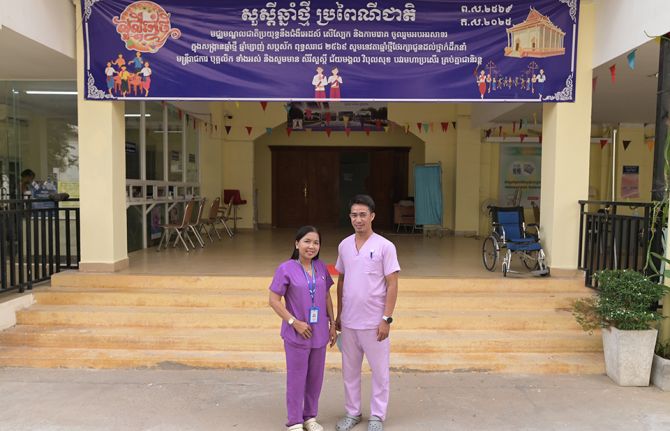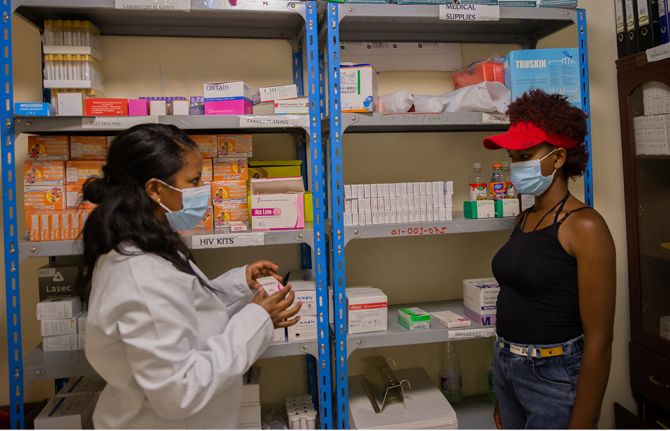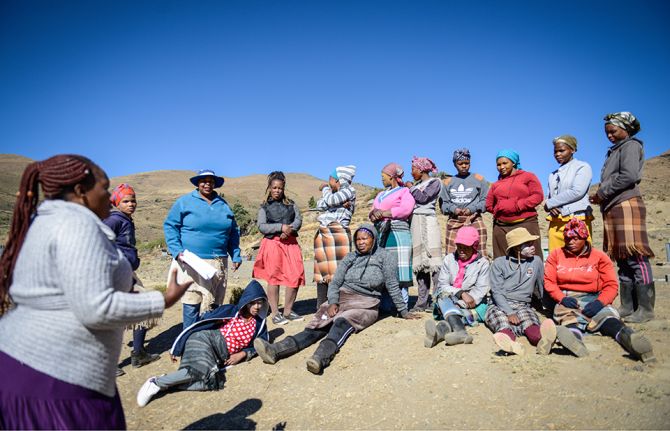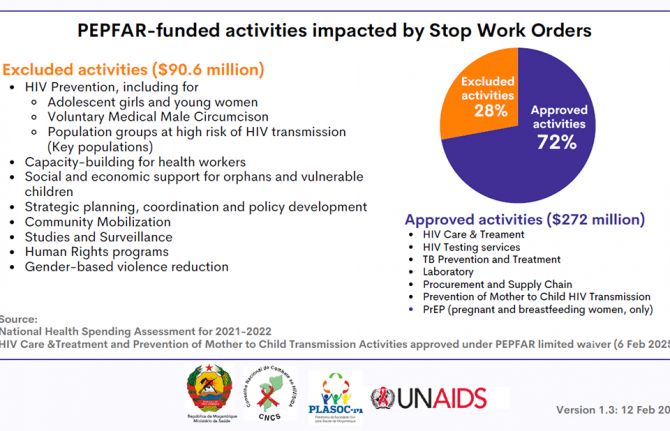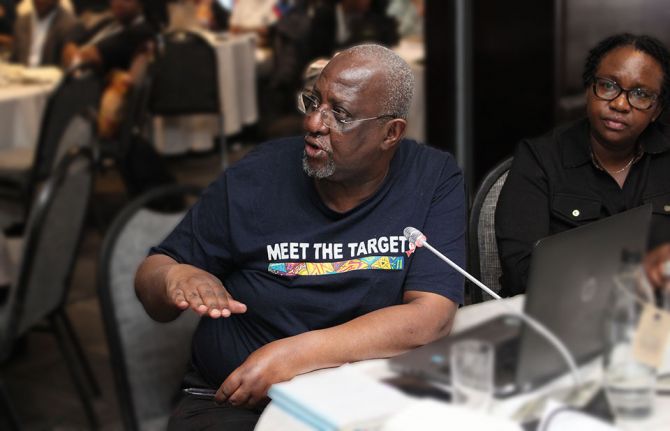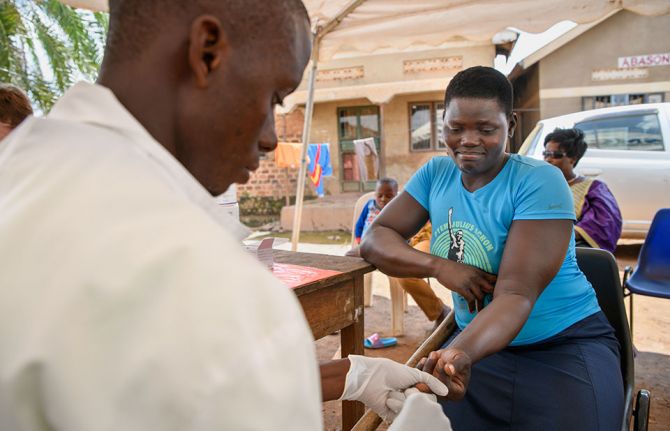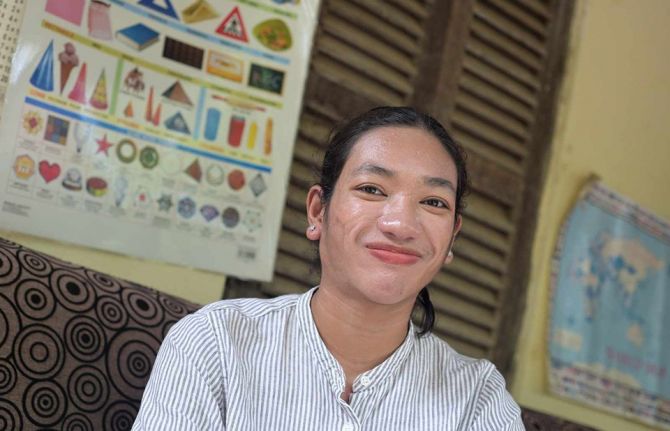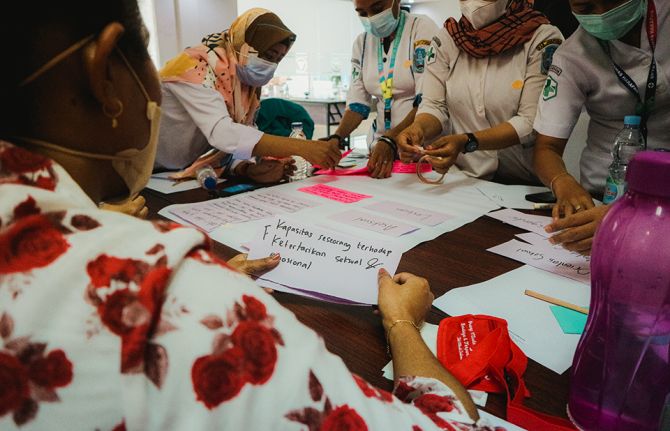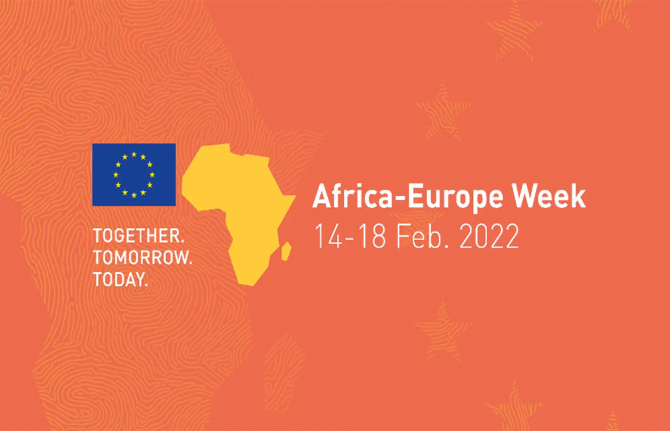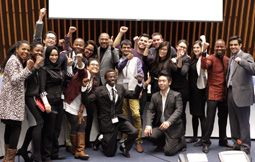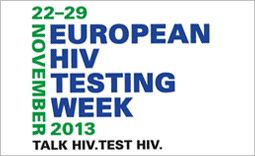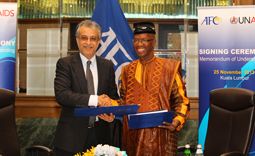
Feature Story
Applying evidence for results: How can we effectively scale up HIV treatment?
10 June 2011
10 June 2011 10 June 2011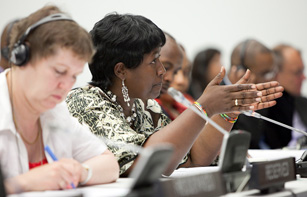
Agnes Binagwaho, Minister of Health, Rwanda at Ministerial Round Table Addressing Access: Taking Programmes to Scale. UN Headquarters, NYC, on June 9, 2011.
Credit: UNAIDS/B. Hamilton
With unprecedented high level participation at this week’s UN General Assembly Meeting on AIDS, with more thirty Heads of State and Government and Vice Presidents and some 100 ministers in attendance. A special side event was convened for the ministers to come together to share their experiences across the new landscape and outlook for HIV treatment, including treatment for prevention. It brought together ministers from a wide spectrum of sectors—including health, justice, social development and labour—with members of civil society, to exchange a diversity of country experiences.
Panellists in the session included Aaron Motsoaledi, Minister of Health, South Africa; José Angel Cordova Villalobos Secretary of Health, Mexico; Marijke Wijnroks, AIDS Ambassador, Netherlands; Ruben Pecchio, Director REDLA+ (Network of People Living with HIV, Latin America) and UNAIDS Executive Director Michel Sidibé.
We must consider the investments we make now as down-payments that will reduce costs later
UNAIDS Executive Director Michel Sidibé
Treatment for prevention
The panel drew attention to the recent results of the HPTN 052 study announced by the United States National Institutes of Health which demonstrated that if an HIV-positive person adheres to an effective antiretroviral therapy regimen, the risk of transmitting the virus to their uninfected sexual partner can be reduced by 96%.
Involvement of people living with HIV essential
In the discussion, moderated by Al Jazeera television host Riz Khan, the participants highlighted the need to involve people living with HIV in treatment and prevention programmes. “Testing needs to be available to everyone—people living with HIV need to know their status as early as possible to enable them to effectively engage in prevention. ‘Positive prevention’ must be at the centre of prevention efforts and treatment for prevention plays a critical role,” said Mr Pecchio.
Addressing stigma in the context of treatment
According to Secretary of Health of Mexico, José Angel Cordova Villalobos, Mexicohas created a financial vehicle to guarantee sustainable access to treatment over long term. “But we must also work to strengthen education to fight stigma and discrimination and homophobia and to increase people’s willingness to get tested,” said Mr Cordova Villalobos.
With the largest number of people living with HIV in the world, at 5.6 million, South Africa also has the largest antiretroviral treatment programme in the world. The country has also recently launched a national HIV testing campaign in which 12 million South Africans have been tested for HIV between April 2010 and June 2011.
We must also work to strengthen education to fight stigma and discrimination and homophobia and to increase people’s willingness to get tested
José Angel Cordova Villalobos, Secretary of Health of Mexico
“South Africa has no option but to scale up treatment. As testing is scaled up, more people learn their status, and given the evidence of its impact on prevention, this is an important approach,” said Aaron Motsoaledi, Minister of Health of South Africa.
Recent developments in scientific understanding and approaches were highlighted and shown how they can be seen as “game changers.” Country representatives discussed how they can apply this information to further scale up HIV treatment programmes. New information about the prevention benefits of HIV treatment provides an opportunity for increased collaboration within the HIV response.
Investment needs
According to the new UNAIDS investment framework published in the Lancet ahead of the High Level Meeting on AIDS, a relatively small amount of additional money would be required to reach the US$ 22 billion needed for universal access to HIV treatment by 2015. However new data indicate that international investments in AIDS appear to be falling for the first time in 10 years.
“We must consider the investments we make now as down-payments that will reduce costs later,” stressed Mr Sidibé. “It is unacceptable that we have the evidence of the incredible effectiveness of treatment for prevention, yet nine million people living with HIV still don’t have access to it.“
External Links
External Links
Multimedia
Multimedia
Related

Feature Story
Market approaches for innovation and access to medicines: Challenges and opportunities
10 June 2011
10 June 2011 10 June 2011
Credit: UNAIDS
What lessons can be learned from market-based approaches to providing medicines and healthcare in low- and middle-income settings? What are the challenges and future opportunities? These were the key questions raised at an event organised by UNITAID, UNAIDS and the Medicines Patent Pool at the High Level Meeting on AIDS in New York on 9 June.
The event, which took the form of a lively debate, was chaired by Philippe Douste-Blazy, Chair of UNITAID’s Executive Board. Andrew Jack of the Financial Times served as moderator. Speakers included UNAIDS Deputy Executive Director, Programme, Dr Paul De Lay, Dr Precious Matsosa, South Africa’s Director General for Health, Brenda Waning, Coordinator of Market Dynamics at UNITAID, Ellen t’Hoen, Executive Director of the Medicines Patent Pool, and Clifford Samuel of Gilead Sciences.
A changing landscape
The participants discussed how globalization and economic development are changing the international health landscape and examined current challenges to innovation and access. They also looked at interventions needed to ensure that emerging new medicines and technologies can be absorbed by health systems in developing countries.
It was noted that the recent adoption of market-based approaches to public health provision by several donors and international organisations, such as UNITAID—which has committed over US$1.5 billion since 2006—has led to sustainable markets for manufacturers, encouraging price reductions and the development of new medicines, such as AIDS drugs.
We need a research and development agenda that meets the specific needs of low- and middle-income countries. This includes ARV that can be used safely with TB treatment, for children, and during pregnancy
Dr Paul De Lay, UNAIDS Deputy Executive Director, Programme
Paradigm shift
However, this paradigm is beginning to shift. For example, by 2008 India had provided 87% of AIDS medicines used in developing countries. Today, Indian manufacturers are turning their attention towards research and development and service in middle-and high-income markets. This leaves potential space for local producers in low-income countries to establish medicine production for their own markets if such access can be promoted.
In his introductory remarks on future challenges and gaps in innovation and access, Dr De Lay stressed that one key innovation challenge was to provide simplified drug regimens and diagnostics to ensure easier supply and greater adherence to treatment in developing countries.
“We need a research and development agenda that meets the specific needs of low- and middle-income countries. This includes ARV that can be used safely with TB treatment, for children, and during pregnancy,” said Dr De Lay.
“We expect that drug optimization will proceed in several phases which will include optimizing existing treatment including dose reductions and frequency, where possible and implementing emerging new technologies including point of care viral load and CD4 testing; next-generation of low cost, highly effective first and second line treatments; and first generation of long-lasting injectable ART.”
Commenting on exactly why new market approaches were needed to meet today’s challenges, Mr Douste-Blazy explained, “UNITAID works to impact on markets and increase access to innovative products at affordable prices. This is the beginning of an era that sees the poorest people start to gain access to the newest, most expensive products at a price their governments can afford.”
Talking specifically about how to promote innovation in the field of HIV that seeks to address developing country needs, Ms t’Hoen contended that the recently created Medicines Patent Pool “could spur innovation in needed formulations for children and combination medicines as well as bring down prices by promoting generic production of newer medicines.”
Dominant national purchasers emerging
The participants also discussed how industrial and economic developments are helping to change the power-base within the global health landscape from large donors to a few dominant national purchasers. For example, the recent tender by the South African government represents approximately 25% of the developing country market for AIDS medicines and the government also self-funds 75% of the country’s ARV purchases in 2010-2011.
Dr Matsoso expanded on the role national governments play in shaping regional and global markets and underlined the importance of fast tracking the registration of new medicines in developing countries. “We need to harmonise medicines regulation at the regional level to ensure faster uptake of new and innovative products in our countries,” she said.
All those taking part in the event committed to redoubling efforts to protect lives by helping to ensure that attractive markets are created for producers while promoting public health goals of continued innovation and universal access to HIV treatment.
As Dr De Lay summed up: “We have all contributed to the accomplishment of vastly increasing the numbers of people living with HIV who are on ART. For the foreseeable future ART demand will be increasing and we expect to see pressures on ART supply, and continuing innovation in research and development of new ART formulations, as well as for laboratory diagnostic and monitoring tests, is required, and this may require new incentive mechanisms.”
External Links

Feature Story
AIDS and Disability Partners Forum: Enhancing inclusive and accessible HIV programming which fits all the population
09 June 2011
09 June 2011 09 June 2011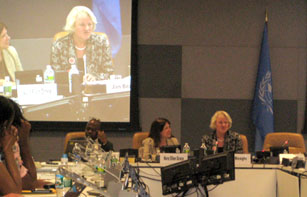
Jan Beagle, UNAIDS Deputy Executive Director, Management and External Relations
Credit: UNAIDS
Although there is growing international attention for the rights of people with disabilities, governments and policymakers rarely consider disability issues when formulating their HIV strategic plans.
To highlight the significance of this area of work and advocate for national integration of the needs of persons with disabilities into all aspects of the AIDS response, a partner’s forum on AIDS and Disability was held on 9 June during the High Level Meeting on AIDS.
The event was co-chaired by Jan Beagle, UNAIDS Deputy Executive Director, Management and External Relations and Professor Nora Ellen Groce, Director, Leonard Cheshire Disability & Inclusive Development Centre at University College London.
“Both the AIDS movement and the disability movement have at their core a respect for human rights of the individual. Both are movements which are confronting sigma and discrimination of different kinds. Both HIV and disability affect not only the individual but also the household, in ways that you all know so well. Where you have both HIV and disability, there's a double stigma, and a double burden,” said Jan Beagle, UNAIDS Deputy Executive Director, Management and External Relations, introducing the event.
Mary Muthoni Rop is a mother of three children who lives in rural Kenya. She has multiple disabilities and is living with HIV. She has become an activist with Thika Disabled Fighting HIV and AIDS and spoke at the event of the myriad difficulties and vulnerability the HIV epidemic has brought to people living with a disability which include obstacles to access to HIV services due to distances and infrastructure of health facilities. “We find that most of the health facilities are not accessible to people with disability: for example a hospital having stairs all over,” she said. HIV prevention information is also often inaccessible. “We find that in most of our health facilities, we don't have people who can give proper information to people with disability. We don't have workers trained in sign language interpretation.”
We've all got to work together: governments in North and South, civil society and in particular, people living with disabilities and people living with HIV
Jan Beagle, UNAIDS Deputy Executive Director, Management and External Relations
In 2006 the United Nations Convention on the Rights of Persons with Disabilities was adopted in 2006 and ratified in 2008. This Convention obliges states to provide access to sexual and reproductive health including HIV information and services for all persons with disabilities. The UN Development Group under the leadership of the UNDP Administrator has developed specific guidance for UN country teams on integrating disability into all its work and that of the UN system at global and regional levels.
Stephen Lewis, co-founder and co-director of AIDS-Free World spoke about the need for national government to transform this global instrument into a tool, saying “countries need to understand that they need to take the Convention and turn international law into national law in order for it to be effective and implemented.”
Disabled people’s organizations in different countries in Africa and Asia are becoming more and more involved in the HIV arena to mainstream disability into HIV programmes. Richard Kabeto Matlhare head of Botswana’s National AIDS Coordinating Agency shared insights from his country’s response.
Etienne Krug, Director of Violence and Injury Prevention and Disability gave an overview of the global report which was launched by the World Health Organization earlier in the day “and the big message of the report is that we cannot continue to ignore the needs of 1 billion people in the world.”
“What the report clearly states is that disability results from impairment, but much more from the barriers that society erects. Barriers such as stigma and discrimination, lack of adequate health care and rehabilitation services, inaccessible transport, buildings, information, communication technologies." said Dr Krug
What’s needed is “attacking those barriers, which contribute to a large number of negative outcomes: poorer health status, poorer employment status, less access to education,” he added.
Summing up the discussion as co-chair, Jan Beagle stressed the actions needed to ensure the needs of persons with disabilities are included into all aspects of the AIDS response. “We know that there's very far to go. However, we know how to do it, and the way to do it is by working together. We've all got to work together: governments in North and South, civil society and in particular, people living with disabilities and people living with HIV.”
The AIDS and Disability Partners Forum was organized by UNAIDS in collaboration with Global Partnership for Disability and Development, Health Canada, USAID, US State Department, ILO, UNDESA, UNICEF and WHO.
UN General Assembly High Level Meeting on AIDS
Thirty years into the AIDS epidemic, and 10 years since the landmark UN General Assembly Special Session on HIV/AIDS, the world has come together to review progress and chart the future course of the global AIDS response at the 2011 UN General Assembly High Level Meeting on AIDS from 8–10 June 2011 in New York. Member States are expected to adopt a new Declaration that will reaffirm current commitments and commit to actions to guide and sustain the global AIDS response.
External Links
External Links
Publications
Publications
- HIV/AIDS and Disability: Final Report of the 4th International Policy Dialogue (Health Canada, 2009)
- Global Survey on HIV/AIDS and Disability (World Bank, 2004)

Feature Story
High Level meeting side-event calls for full inclusion and recognition of key populations at risk of HIV in all responses to HIV
10 June 2011
10 June 2011 10 June 2011
Credit: UNIC
Stigma and discrimination and punitive legal environments continue to block people around the world from accessing the HIV services they need. Thirty years into the epidemic they still represent a major barrier to universal access to HIV prevention, treatment, care and support. To find ways to overcome these obstacles, a community dialogue event provided members of key populations at higher risk of HIV a critical and groundbreaking platform at the UN General Assembly High Level Meeting on AIDS to share their expertise and experience. The panellists—who represented leaders among men who have sex with men, people who inject drugs, transgendered people and sex workers—reinforced the call for full recognition and protection of their human rights in all national HIV responses.
Ten years since the 2001 Declaration of Commitment, in which Member States committed to eliminate discrimination against people living with HIV and vulnerable groups, many countries still lack anti-discrimination laws and use punitive approaches to key populations that create barriers between them and HIV services. Countries cite stigma as the single greatest impediment to accelerating progress in the HIV response; however, stigma reduction programmes are neither adequately resourced, taken to scale or targeted to benefit key populations.
The event, hosted by the UK and South Africa Governments and partnered by the International HIV/AIDS Alliance (IAA) and International Federation of the Red Cross (IFRC), was an opportunity for leaders from key populations at risk of HIV to describe what is needed and what is working in the criminalized and discriminatory environments in which they live their everyday lives. Many communities have taken bold steps to overcome human rights abuses and lack of access to HIV services—organizing to demand their rights, providing services through their peers, working with local police and government leaders for recognition and protection. What is needed now is greater support and political, legal and social space for these groups to continue to find and implement such solutions that work for them.
Rather than simply describing the barriers they face in accessing services, they highlighted examples where their key affected population has achieved greater access and offered concrete solutions on how we can address these obstacles in a practical way.
Full respect for the human rights of key populations and evidence-based interventions targeted to the realities they face, as well as support for their leadership and capacity to find solutions for their communities, are all critical to advance the AIDS response
Jan Beagle, UNAIDS Deputy Executive Director, Management and External Relations
United Kingdom Minister for International Development, Stephen O’Brien, in his introductory remarks stressed that for effective AIDS responses, it is essential to work with key populations without prejudice and address restrictive laws that are hampering access to services for key populations.
Alexei Kurmanayevsky from Russia shared his experience as a person who injects drugs and is living with HIV. The panel also included Penninah Mwangi who is the Director of Bar Hostess Association, Nairobi, Kenya—one of the longest standing sex worker-led organizations in Africa. Marcela Romero from Argentina spoke as a transgender person. Othman Mellouk from Morocco spoke about the barriers to delivering effective HIV services to men who have sex with men.
The event was chaired by Michaela Clayton, Executive Director of ARASA and Co-chair of UNAIDS Reference Group on HIV and Human Rights, who also invited interventions from the floor. Jan Beagle, UNAIDS Deputy Executive Director, Management and External Relations, stressed the need for a rights-based approach when addressing HIV. "Full respect for the human rights of key populations and evidence-based interventions targeted to the realities they face, as well as support for their leadership and capacity to find solutions for their communities, are all critical to advance the AIDS response," Ms Beagle said.
The key recommendations from each speaker and the floor discussion were collated into a list of recommended next steps to be presented to the Chairs of the High Level Meeting on AIDS.
UN General Assembly High Level Meeting on AIDS
Thirty years into the AIDS epidemic, and 10 years since the landmark UN General Assembly Special Session on HIV/AIDS, the world has come together to review progress and chart the future course of the global AIDS response at the 2011 UN General Assembly High Level Meeting on AIDS from 8–10 June 2011 in New York. Member States are expected to adopt a new Declaration that will reaffirm current commitments and commit to actions to guide and sustain the global AIDS response.
External Links
External Links
Related

Feature Story
Can MDG 6 be achieved with the Health Workforce we have?
09 June 2011
09 June 2011 09 June 2011
Credit: AMREF
If international aims such as achieving health-related Millennium Development Goals (MDGs) and universal access to HIV services are to be realized, the serious global shortage of health workers must be urgently addressed. This shortage has been severely exacerbated by the AIDS epidemic reducing staff numbers and significantly increasing the workload of those remaining.
At a side event during the High Level Meeting on AIDS in New York this week, the need to recognise human resources as a crucial element in the global AIDS response was explored in depth. Without sufficient human resources, countries' efforts to scale up comprehensive AIDS services will not be sustained, making it impossible to reach the MDGs.
The meeting, Can MDG 6 be achieved with the Health Workforce we have?, was jointly organized by the Global Health Workforce Alliance (GHWA), along with the Government of Brazil, the Commonwealth Secretariat, UNAIDS and the African Medical and Research Foundation (AMREF).
A lively panel discussion, including heads of state, senior representatives from donor and international organisations, civil society and the private sector, examined the interconnectivity of HIV and human resources and also shared best practices.
Joining discussants Mphu Ramatlapeng, both Global Fund Vice-chair and Lesotho’s Health Minister and Secretary Jarbas Barbosa, Brazil’s Secretary of Health Surveillance, were keynote speakers Dileita Mohamed Dileita, Prime Minister of Djibouti and Maxensia Nakibuuka, a Ugandan community health worker living with HIV. The session was moderated by Pulitzer prize-winning journalist Laurie Garrett, who is also Senior Global Health Fellow at the Council on Foreign Relations research centre.
Mr Dileita Mohamed Dileita highlighted the effects of an insufficient number of health workers, their uneven distribution, and limitations in their competencies in his own country, Djibouti. Dr Barbosa agreed that uneven distribution of staff is a major problem in Brazil.
Speaking as a community health worker Maxensia Nakibuuka from Uganda emphasized the difficulties she and her colleagues faced, “We are left to do it alone. Without system strengthening, without budgets; with nothing…We need to be recognized.”
According to Mphu Ramatlapeng, the Global Fund is helping countries meet their needs, with round 11 of Fund proposals including support for health workforce strengthening. She also stressed the crucial need for all stakeholders to work together.
The role of the private sector in offering support was examined. Michael Bzdak, Johnson & Johnson ‘s Director of Contributions and Community relations, spoke of their corporate social responsibility and building health care capacity, primarily in terms of leadership, management techniques and skills training.
Dr Sigrun Mogedal, former-Ambassador, HIV/AIDS and Global Health Initiatives, Norway, and former Chair of the GHWA board, commented on the need to “do things differently.” She referred to the recently released Alliance taskforce report Will we achieve universal access to HIV/AIDS services with the health workforce we have? A snapshot from five countries and stressed actions required by governments and other decision makers. These include: estimating numbers and types of health workers needed to reach international targets; strengthening health workforce management systems; implementing costed plans for increasing and improving the health workforce; and scaling up successful approaches.
Another important aspect raised was the need to focus considerable attention not only on workforce training but on staff retention strategies, looking at motivation and job satisfaction. This point was made by Dr John Palen, Senior HRH advisor of the US President’s Emergency Plan for AIDS Relief (PEPFAR).
The answer to the central question posed was a sobering one: if the impact of AIDS on health workers is not seriously addressed, the human resources crisis will worsen and MDG 6 will become almost impossible to attain. Although progress is being made, there are still many gaps and challenges to overcome.
A report of the meeting will be made available shortly.
Related

Feature Story
New world report on disability: Breaking down barriers
09 June 2011
09 June 2011 09 June 2011
Credit: WHO
The world’s one billion people living with disabilities have poorer health, lower educational achievements and are more prone to social exclusion than those without disabilities. Launched 9 June, the first ever World Report on Disability challenges these disparities and suggests how they can be overcome.
The launch event, which took place during the High Level Meeting on AIDS in New York, was hosted by World Health Organization (WHO) Director-General Dr Margaret Chan and World Bank Vice President Tamar Manuelyan Atinc. The report is produced by both organizations and the two heads were joined by other dignitaries and by representatives of government and civil society.
The publication is a global call to action and assists implementation of the groundbreaking international treaty, the Convention on the Rights of Persons with Disabilities, which was adopted in May 2008. Concerned with national, regional and global policy, it also includes the perspectives of many people who are living with disabilities. In addition, it features the first new disability prevalence estimates for more than three decades: it contends that prevalence is likely to rise in the future due, in part, to the increase in chronic diseases and ageing populations.
We must do more to break the barriers which segregate people with disabilities, in many cases forcing them to the margins of society
Dr Margaret Chan, Director-General, World Health Organization
During the launch event the speakers described the difficulties people with disabilities face, including barriers to accessing health, education, employment and information services.
According to Dr Chan, "Disability is part of the human condition. Almost every one of us will be permanently or temporarily disabled at some point in life. We must do more to break the barriers which segregate people with disabilities, in many cases forcing them to the margins of society."
UNAIDS Executive Director Michel Sidibé called for “an end to all discrimination and inequity faced by people living the disabilities, which not only rob people of their dignity, but block their access to HIV prevention, treatment, care and support.”
HIV and people with disabilities
According to the UNAIDS, WHO and OHCHR policy brief on HIV and disability people with disabilities may be at risk of HIV infection due to a number of reasons, including insufficient access to appropriate HIV prevention and support services, and their higher risk of experiencing sexual assault or abuse during their lifetime. They may also be turned away from HIV education forums or not be invited by outreach workers, because of assumptions that they are not sexually active, or do not engage in other risk behaviours such as injecting drugs.
There must be an end to all discrimination and inequity faced by people living the disabilities, which not only rob people of their dignity, but block their access to HIV prevention, treatment, care and support
Michel Sidibé, UNAIDS Executive Director
The new report gives examples of the issues and situation concerning HIV and people with disabilities. A survey commissioned by the Zimbabwe Parents of Handicapped Children’s Association demonstrated that hearing and visually impaired people were excluded from HIV services because they were not offered in sign language or Braille. On the other hand, there are many examples throughout the report of how individuals, organizations, countries and regions are promoting good practice.
The goal of the World Report on Disability is to provide information and strategic guidance to key actors, such as policy makers, donors and practitioners. A series of recommendations include: investing in specific programmes and services for people with disabilities; adopting a national strategy and action plan; involving people with disabilities in policy and planning decisions and raising public awareness and understanding.
External Links
External links
Publications
Publications
- World report on disability (WHO/World Bank, 2011)
- Disability and HIV policy brief
Multimedia
Multimedia
Related
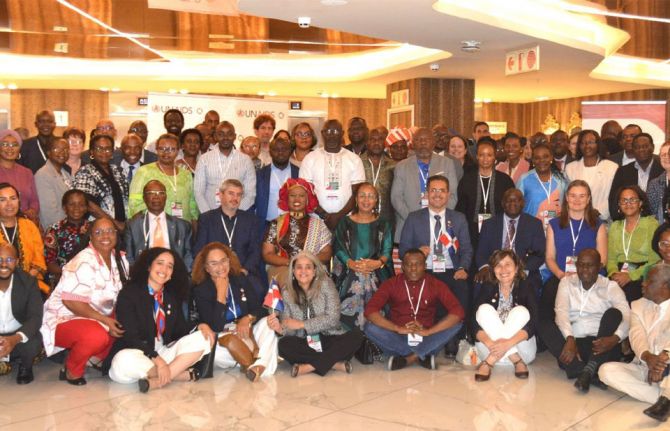 Building country-led sustainable HIV responses
Building country-led sustainable HIV responses

20 December 2024
 Towards a life of dignity for people living with disabilities
Towards a life of dignity for people living with disabilities

15 February 2022

Feature Story
It’s possible: Making the most of linking sexual and reproductive health and HIV responses
09 June 2011
09 June 2011 09 June 2011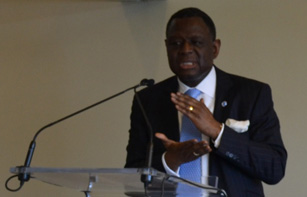
Dr Babatunde Osotimehin.
Credit: UNFPA
Linking sexual and reproductive health and HIV is of critical importance. Worldwide more than 80% of HIV infections are sexually transmitted. In addition, sexual and reproductive ill health and HIV are fueled by similar causes such as poverty, limited access to services, lack of correct information, gender inequality and social marginalization.
On 8 June, during a side event at this week’s General Assembly High Level Meeting on AIDS in New York, the question of how exactly such linkages can be strengthened was explored. The event was sponsored by UNAIDS, the UN Educational, Scientific and Cultural Organization (UNESCO), the UN Population Fund (UNFPA), the World Health Organization (WHO), and the International Planned Parenthood Federation (IPPF).
The highly interactive session looked at the issue through the prism of five key thematic areas: cost-effectiveness and cost savings of linkages; prevention of mother to child transmission though a sexual and reproductive health platform; comprehensive sexuality education for young people; ending gender-based violence; and human rights of people living with HIV.
Making ‘people-sense’
In his opening remarks, Dr Babatunde Osotimehin, UNFPA Executive Director, explained how the integration of sexual and reproductive health and HIV services makes ‘people-sense’. These services include testing for HIV and other sexually transmitted infections, prevention of mother-to-child transmission, support for fertility decisions, and access to condoms, contraception and correct information. He went on to emphasize wider policy and human rights implications.
“Linking sexual and reproductive health and HIV goes beyond integrating health services,” he said. “It demands from us that we fortify the human rights platform–ending stigma, violence and discrimination.”
Human rights and the right to health were said to be at the core of greater integration of services. A broader human rights agenda can also be promoted that goes beyond service delivery and tackles legal reforms, such as those relating to the right to information and freedom from violence, abuse and coercion.
Sharing ideas and experience
The participants shared ideas and experiences of how those working in the fields of HIV and sexual and reproductive health have combined their efforts to make interventions more effective in creative and innovative ways, including strategies to strengthen treatment as a prevention option.
It was stressed that mother- and child-centred care can improve both sexual and reproductive health and HIV outcomes. For many women, pregnancy is the first point of access in the health system and they can benefit from a range of interventions, including HIV prevention and treatment integrated into routine maternal health care; family planning; and preventing and managing sexually transmitted infections and gender-based violence.
The discussion also showed that when comprehensive sexuality education is effectively implemented on a national scale, there is potential for cost saving from averting HIV infections, other STIs and unintended pregnancies.
Participants examined how men can benefit from greater integration. For instance, in countries where voluntary male circumcision is being implemented for HIV prevention, the number of men accessing other sexual and reproductive services, such as prevention of mother-to-child transmission and treatment of STIs, has increased.
The meeting closed with agreement that linking sexual and reproductive health and the HIV response, especially in a climate of austerity, is a gateway to strengthening both the human rights agenda and health systems.
External links
Related

Feature Story
High level panel highlights need for greater investments in technology and innovation to advance results for HIV prevention for treatment
10 June 2011
10 June 2011 10 June 2011
Ratu Epeli Nailatikau, President of the Republic of Fiji, chairs the panel discussion on Innovation and new technologies, 9 June 2011. Credit: UN Photo/Paulo Filgueiras
Progress in reducing the number of new HIV infections and increasing access to antiretroviral treatment over the past three decades did not happen haphazardly but were in large part due to a concerted international effort that bridged technology and innovation for results in HIV prevention and treatment.
This emerged from an official panel entitled Innovation and new technologies, one of five panels in which high level representatives from member states and civil society are holding as part of the 2011 United Nations General Assembly High Level Meeting on AIDS.
Chaired by HE President Ratu Epeli Nailatikau of Fiji, the panel brought together the Director-General of the World Health Organization, Dr Margaret Chan; the Minister of Health of Mexico, Dr Jose Angel Cordova Villalobos; and Dr Christoforos Mallouris, Director of Programmes, Global Network of People Living with HIV (GNP+).
The panellists shared their insights on how technology and innovation have played instrumental roles in helping realize the results achieved in the AIDS response to date. One example cited was the increase in the past decade of the number of people living with HIV on antiretroviral treatment: in 2010 that figure stood at 6.6 million up from 240 000 in 2001. Cited as central to this unprecedented development was a combination of innovative technology that led to highly effective antiretroviral medicines and improved access to that technology through the availability of low-cost, quality-assured drugs.
Doing more of the same is not enough. We need innovation urgently.
World Health Organization Director-General Dr Margaret Chan
“Collaboration with developing countries will be crucial," said President Nailatikau who highlighted the need to find innovative solutions at the heart of the disease. “With this, we have a chance to make a huge impact against one of the greatest health and development challenges of our generation.”
Moderated by British journalist Andrew Jack from the Financial Times, the discussion focused substantially on the several challenges facing the AIDS response from the technology and innovation perspective, mainly the necessity to urgently expand access to newer and improved HIV technologies, such as better diagnostics for CD4 and viral load counts, and increased investments in biomedical prevention technologies such as microbicides.
The panellists agreed that access to proven HIV prevention technologies—from male and female condoms to male circumcision—must continue to be scaled up and governments should ensure policies are in place within their national responses that foster innovation and advancement, from both the public and private sector. Innovative partnerships that create financial or other incentives to spur research and development were viewed as key elements.
“Let’s not let the pace of the epidemic get beyond us. We have the capacity for innovation to recreate ourselves to achieve not only zero new infections, zero discrimination and zero AIDS-related deaths; but also for zero homophobia and transphobia, zero gender-discrimination and human rights for all,” said President Felipe Calderón of Mexico,
Echoing a “positive health, dignity and prevention” approach, Dr Mallouris of GNP+ urged for greater involvement of people living with HIV in prevention. “People living with HIV also need prevention and new prevention technologies. We need to ensure that people living with HIV are involved—we are not just vessels of transmission, we want prevention too,” said Dr Mallouris.
The panel also drew attention to the recent results of the HPTN 052 study announced by the United States National Institutes of Health which demonstrated that if an HIV-positive person adheres to an effective antiretroviral therapy regimen, the risk of transmitting the virus to their uninfected sexual partner can be reduced by 96%. Attention was also given to the ongoing search for an HIV vaccine that, although estimated to be decades away, is considered by many in the AIDS community as an essential component of the future AIDS response.
“Doing more of the same is not enough,” said World Health Organization Director-General Dr Chan. “We need innovation urgently and we are still running behind this devastating epidemic. We know now…beyond doubt that early treatment has a powerful effect on transmission in sero-discordant couples—we must maximize the preventive effects of treatment by early diagnosis.”
However in both the short- and medium-term, the panel stressed the importance of rapidly expanding access to antiretroviral treatment as one of the most pressing issues. With about nine million people in low- and middle-income countries who are eligible for treatment in need, the panel encouraged countries to give priority to transferring research and technology as well as to provide sufficient funding for the research and development of safer, more effective antiretroviral medicines that are also easier to use.
UN General Assembly High Level Meeting on AIDS
Thirty years into the AIDS epidemic, and 10 years since the landmark UN General Assembly Special Session on HIV/AIDS, the world has come together to review progress and chart the future course of the global AIDS response at the 2011 UN General Assembly High Level Meeting on AIDS from 8–10 June 2011 in New York. Member States are expected to adopt a new Declaration that will reaffirm current commitments and commit to actions to guide and sustain the global AIDS response.
External links
External links
Multimedia
Multimedia
Publications
Publications
- Backgrounder Panel 3: Innovation and new technologies (pdf, 160 Kb)
Related

Press Release
First Ladies of the world unite to prevent new HIV infections among children
08 June 2011 08 June 2011First Ladies join forces to call for integration of HIV and maternal, newborn and child health programmes at special event during United Nations High Level Meeting on AIDS

(Left to Right): Michel Sidibé, Executive DIrector of UNAIDS; HE Mrs. Azeb Mesfin, First Lady of Ethiopia; Mrs. Ban Soon-taek, Spouse of Secretary General of the United Nations; Dr. Bun Rany Hun Sen, Cambodia.
Credit: UNAIDS/B. Hamilton
NEW YORK/GENEVA, 8 June 2011—Thirty First Ladies from Africa, Asia, Latin America and the Caribbean gathered at a special event in New York to mobilize support around achieving the Joint United Nations Programme on HIV/AIDS’ (UNAIDS) vision of Zero new HIV infections among children by 2015. The event was held on the opening day of the UN High Level Meeting on AIDS which is taking place in New York from 8-10 June.
Mrs Ban Soon-taek, wife of the United Nations Secretary-General; Mrs Azeb Mesfin, First Lady of Ethiopia and President of the Organization of African First Ladies Against HIV/AIDS; and Mr. Michel Sidibé, Executive Director of UNAIDS co-hosted the New York event.
Around 1,000 babies are infected with HIV each day, 90% of whom are in countries in sub-Saharan Africa. HIV is also the leading cause regarding mortality among women of reproductive age in developing countries. The First Ladies agreed to advocate for comprehensive and integrated access to maternal and child health services that include services to prevent HIV transmission among infants and which keep mothers and children healthy.
Gender inequality, gender violence, discrimination and inequitable laws prevent pregnant women from accessing HIV testing and counselling, prevention, treatment and support services. “Women and girls must be at the centre of the AIDS response,” said Michel Sidibé. “When women protect themselves from HIV, they protect a whole new generation from HIV.”
More than 2 million children worldwide are living with HIV, mostly in sub-Saharan Africa. In Western Europe only 1,400 children are living with HIV, highlighting the global injustice of unequal access to maternal and child health services and the urgent need to increase access to HIV services for pregnant women in low- and middle-income countries.
“If women around the world are not involved in facing the challenge of preventing mother-to-child transmission of HIV, we cannot win. If we all play our part, we cannot fail.” said Mrs Mesfin.
In recent years, a number of countries have made great strides in reducing the rate of new HIV infections among children and globally in 2009, new HIV infections among children dropped by 25%.
“The fact that, in still too many places, HIV positive women are denied the right to give birth to healthy babies is a global injustice that we can end by 2015,” said Mrs Ban.
On return to their respective countries, the First Ladies agreed to advance ten action steps to ensure that children are born free from HIV and to promote lifesaving HIV services for women and children. These include supporting efforts to; increase the number of centres providing free maternal, newborn and child health services, including treatment to prevent the transmission of HIV from mothers to children; strengthen sexual and reproductive health programs for adolescents living with HIV; ensure meaningful engagement of people living with HIV; and promote zero tolerance for stigma and discrimination against people living with HIV.
Multimedia
Multimedia
Related information
Related information
Press centre
Download the printable version (PDF)

Feature Story
2011 General Assembly High Level Meeting on AIDS opens
08 June 2011
08 June 2011 08 June 2011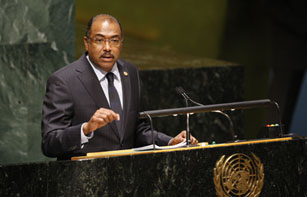
UNAIDS Executive Director addressing the opening plenary of the 2011 General Assembly High Level Meeting on AIDS
Credit: UN Photo/Paulo Filgueiras
Heads of State and Government and other high level representatives representing Member Nations gathered today in the General Assembly Hall of the United Nations (UN) in New York for the opening plenary of the 2011 General Assembly High Level Meeting on AIDS.
More than 30 Heads of State, Government and Vice Presidents will attend the meeting which will include official plenary—in which 150 speakers representing Member States, Observers, civil society and private sector are expected to speak—and five panel sessions along with 40 individual side events.
Joseph Deiss, President of the 65th session of the UN General Assembly, opened the event. Secretary-General Ban Ki-moon also addressed the opening plenary.
Addressing the opening UNAIDS Executive Director Michel Sidibé called on the gathered leaders to “agree on a transformational agenda to end this epidemic—one that will achieve our vision of zero new HIV infections, zero discrimination and zero AIDS-related deaths.”
“Getting to zero is not an aspirational goal or a magic number. It must be our common plan—to be transformed into reality,” Mr Sidibé added.
Getting to zero is not an aspirational goal or a magic number. It must be our common plan—to be transformed into reality
UNAIDS Executive Director Michel Sidibé
At a press conference ahead of the meeting, Mr Deiss highlighted the significance of the event. “The momentum around this meeting is unprecedented and promises to make this an historic event. We are looking to UN Member States to make bold commitments which will help us reach our shared goal,” he said.
The gathering takes place thirty years into the AIDS epidemic, and 10 years since the landmark UN General Assembly Special Session on HIV/AIDS. Member States are expected to adopt a new Declaration that will reaffirm current commitments and commit to actions to guide and sustain the global AIDS response.
On the final day of the High Level Meeting on AIDS, UN Member States are expected to adopt a declaration which will guide country responses to HIV over the next five years.
Speeches
Speeches
- President of the 65th session of the UN General Assembly (8 June 2011)
- UN Secretary-General Ban Ki-moon (8 June 2011)
- UNAIDS Executive Director Michel Sidibé (8 June 2011)
Related
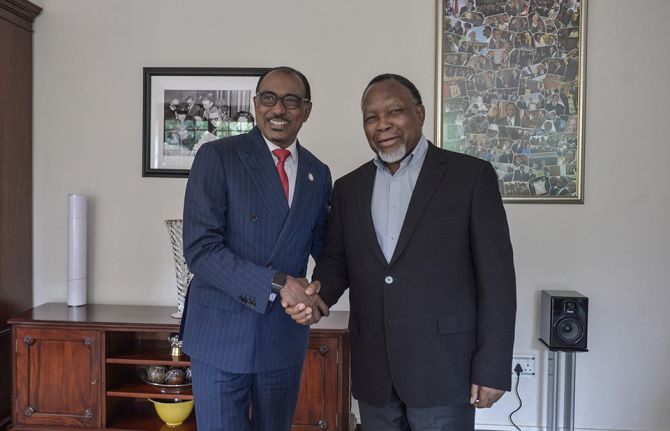 Keeping up the momentum in the global AIDS response
Keeping up the momentum in the global AIDS response

24 April 2019
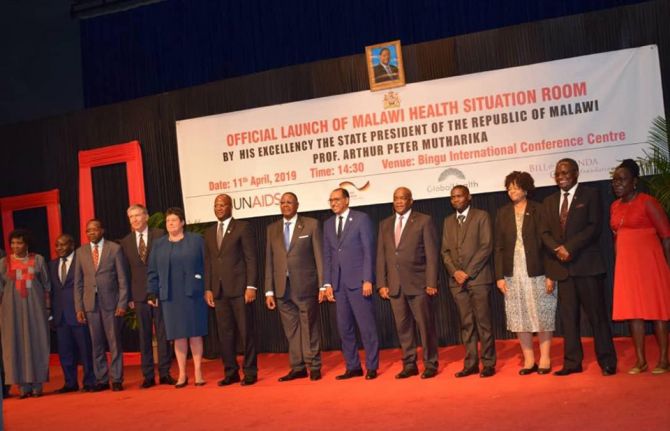 Malawi launches its health situation room
Malawi launches its health situation room

12 April 2019
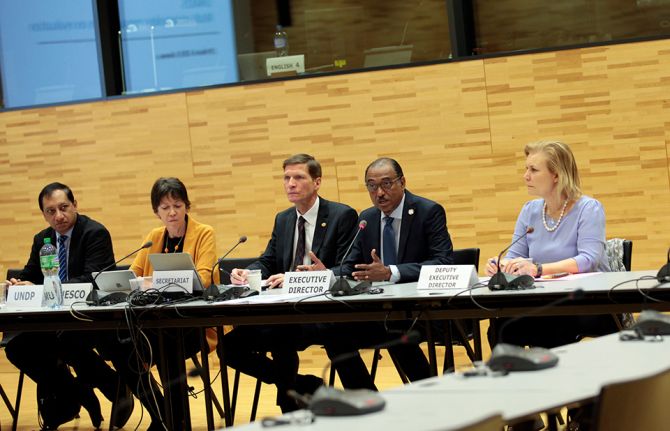 Learning lessons on evaluation
Learning lessons on evaluation

02 April 2019

